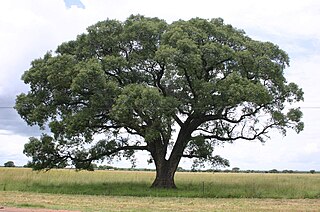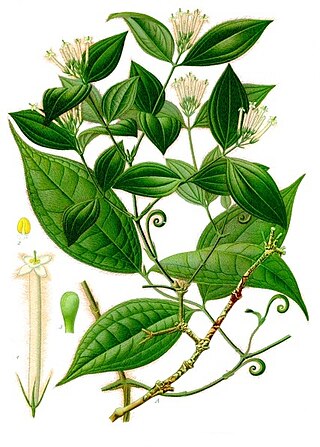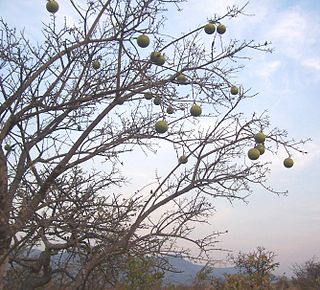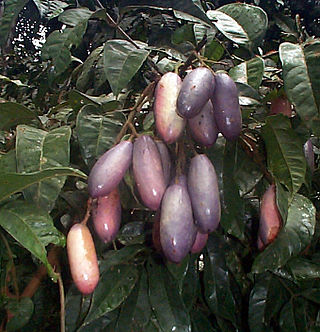
A mango is an edible stone fruit produced by the tropical tree Mangifera indica. It is believed to have originated between northwestern Myanmar, Bangladesh, and northeastern India. M. indica has been cultivated in South and Southeast Asia since ancient times resulting in two types of modern mango cultivars: the "Indian type" and the "Southeast Asian type". Other species in the genus Mangifera also produce edible fruits that are also called "mangoes", the majority of which are found in the Malesian ecoregion.

Maclura pomifera, commonly known as the Osage orange, is a small deciduous tree or large shrub, native to the south-central United States. It typically grows about 8 to 15 metres (30–50 ft) tall. The distinctive fruit, a multiple fruit, is roughly spherical, bumpy, 8 to 15 centimetres (3–6 in) in diameter, and turns bright yellow-green in the fall. The fruits secrete a sticky white latex when cut or damaged. Despite the name "Osage orange", it is not related to the orange. It is a member of the mulberry family, Moraceae. Due to its latex secretions and woody pulp, the fruit is typically not eaten by humans and rarely by foraging animals. Ecologists Daniel H. Janzen and Paul S. Martin proposed in 1982 that the fruit of this species might be an example of what has come to be called an evolutionary anachronism—that is, a fruit coevolved with a large animal seed dispersal partner that is now extinct. Evidence and arguments pro and con their hypothesis followed for decades afterwards.

Carambola, also known as star fruit, is the fruit of Averrhoa carambola, a species of tree native to tropical Southeast Asia. The edible fruit has distinctive ridges running down its sides. When cut in cross-section, it resembles a star, giving it the name of star fruit. The entire fruit is edible, usually raw, and may be cooked or made into relishes, preserves, garnish, and juices. It is commonly consumed in Southeast Asia, South Asia, the South Pacific, Micronesia, parts of East Asia, the United States, parts of Latin America, and the Caribbean. The tree is cultivated throughout tropical areas of the world.

A clementine is a tangor, a citrus fruit hybrid between a willowleaf mandarin orange and a sweet orange, named in honor of Clément Rodier, a French missionary who first discovered and propagated the cultivar in Algeria. The exterior is a deep orange colour with a smooth, glossy appearance. Clementines can be separated into 7 to 14 segments. Similar to tangerines, they tend to be easy to peel. They are typically juicy and sweet, with less acid than oranges. Their oils, like other citrus fruits, contain mostly limonene as well as myrcene, linalool, α-pinene and many complex aromatics.

Tamarind is a leguminous tree bearing edible fruit that is indigenous to tropical Africa and naturalized in Asia. The genus Tamarindus is monotypic, meaning that it contains only this species. It belongs to the family Fabaceae.

The jackfruit, also known as the jack tree, is a species of tree in the fig, mulberry, and breadfruit family (Moraceae). Its origin is in the region between the Western Ghats of southern India.

Sclerocarya birrea, commonly known as the marula, is a medium-sized deciduous fruit-bearing tree, indigenous to the miombo woodlands of Southern Africa, the Sudano-Sahelian range of West Africa, the savanna woodlands of East Africa and Madagascar.

Citrus production encompasses the production of citrus fruit, which are the highest-value fruit crop in terms of international trade. There are two main markets for citrus fruit:

Strychnos nux-vomica, the strychnine tree, also known as nux vomica, poison fruit, semen strychnos, and quaker buttons, is a deciduous tree native to India and to southeast Asia. It is a medium-sized tree in the family Loganiaceae that grows in open habitats. Its leaves are ovate and 5–9 centimetres (2–3.5 in) in size. It is known for being the natural source of the extremely poisonous compound strychnine.

The Jaffa orange, also known by their Arabic name, Shamouti orange, is an orange variety with few seeds and a tough skin that makes it particularly suitable for export.

Strychnos is a genus of flowering plants, belonging to the family Loganiaceae. The genus includes about 100 accepted species of trees and lianas, and more than 200 that are as yet unresolved. The genus is widely distributed around the world's tropics and is noted for the presence of poisonous indole alkaloids in the roots, stems and leaves of various species. Among these alkaloids are the well-known and virulent poisons strychnine and curare.

Irvingia gabonensis is a species of African trees in the genus Irvingia, sometimes known by the common names wild mango, African mango, or bush mango. They bear edible mango-like fruits, and are especially valued for their fat- and protein-rich nuts.

An orange is a fruit of various citrus species in the family Rutaceae ; it primarily refers to Citrus × sinensis, which is also called sweet orange, to distinguish it from the related Citrus × aurantium, referred to as bitter orange. The sweet orange reproduces asexually ; varieties of sweet orange arise through mutations.

Strychnos spinosa, the Natal orange, is a tree indigenous to tropical and subtropical Africa. It produces sweet-sour, yellow fruits, containing numerous hard brown seeds. Greenish-white flowers grow in dense heads at the ends of branches. The fruits tend to appear only after good rains. It is related to the deadly Strychnos nux-vomica, which contains strychnine. The smooth, hard fruit are large and green, ripen to yellow colour. Inside the fruit are tightly packed seeds, which may be toxic, surrounded by a fleshy, brown, edible covering. Animals such as baboon, monkeys, bushpig, nyala and eland eat the fruit. The leaves are a popular food source for browsers such as duiker, kudu, impala, steenbok, nyala and elephant.

Monkey orange is a common name for several trees that produce fruits that are superficially similar to orange (citrus).

Dacryodes edulis is a fruit tree in the Burseraceae family native to Africa. Its various regional names include safou, plum (Cameroon), atanga, ube, elumi (Nigeria), African pear, bush pear, African plum, nsafu, bush butter tree, or butterfruit.

Strychnos pungens is a tree which belongs to the Loganiaceae. Usually about 5m tall, occurring in mixed woodland or in rocky places. Branches are short and rigid. Leaves are smooth, stiff, opposite, elliptic and with a sharp, spine-like tip. Occurring in South Africa on the Witwatersrand, Magaliesberg and further north to northern Namibia, northern Botswana and Zimbabwe.

Uapaca kirkiana, the sugar plum or mahobohobo, is a species of dioecious plant in the family Phyllanthaceae. It is native to the southern Afrotropics, where it occurs in well-watered miombo woodlands. Within range it is one of the most popular wild fruits. It is rarely cultivated but trees are left when land is being cleared. Still a traditional food plant in Africa, this little-known fruit has the potential to improve nutrition, boost food security, foster rural development and support sustainable land care.

Mangifera indica, commonly known as mango, is a species of flowering plant in the family Anacardiaceae. It is a large fruit tree, capable of growing to a height of 30 metres. There are two distinct genetic populations in modern mangoes – the "Indian type" and the "Southeast Asian type".

Strychnos madagascariensis, the black monkey orange, is an African tropical and sub-tropical tree belonging to the Loganiaceae family. It is a tree with characteristically large fruit but can confused with some other species of the genus.



















